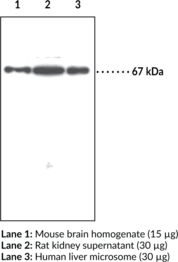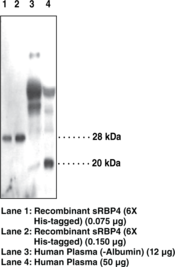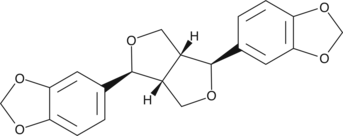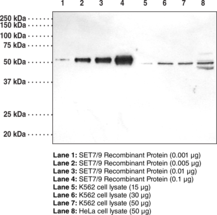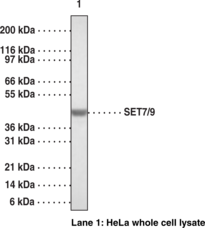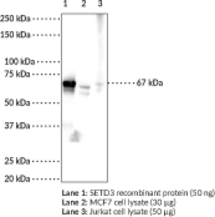Cayman
Showing 39301–39450 of 45550 results
-
Senktide is a potent, selective agonist of the neuromedin K3 (NK3) receptor (EC50 = 0.5-3 nM).{28054,28052,28050} It less potently agonizes the NK1 receptor (EC50 = 35 µM) and is without effect on the NK2 receptor.{28054,28052,28050} Senktide is used to study the action of the NK3 receptor in cells and in animals.{28051,28053}
Brand:CaymanSKU:-Out of stock
Senkyunolide A is a phthalide originally isolated from celery seed essential oil that has cytoprotective and antiproliferative activities.{42461} It protects against cell injury induced by corticosterone in PC12 cells in a time-dependent manner when used at concentrations ranging from 0.125 to 0.5 mg/ml and reduces corticosterone-induced apoptosis at a concentration of 0.5 mg/ml.{42462} It also reverses increases in protein levels of phosphatase 2A (PP2A) and α-synuclein and reverses decreases in the phosphorylated forms of PP2A and α-synuclein. Senkyunolide A inhibits cell proliferation of HT-29 colon cancer (IC50 = 54.17 µM) but not non-cancerous human CCD-18Co colon cells (IC50 = 109.11 µM).{42463}
Brand:CaymanSKU:25199 - 1 mgAvailable on backorder
Senkyunolide A is a phthalide originally isolated from celery seed essential oil that has cytoprotective and antiproliferative activities.{42461} It protects against cell injury induced by corticosterone in PC12 cells in a time-dependent manner when used at concentrations ranging from 0.125 to 0.5 mg/ml and reduces corticosterone-induced apoptosis at a concentration of 0.5 mg/ml.{42462} It also reverses increases in protein levels of phosphatase 2A (PP2A) and α-synuclein and reverses decreases in the phosphorylated forms of PP2A and α-synuclein. Senkyunolide A inhibits cell proliferation of HT-29 colon cancer (IC50 = 54.17 µM) but not non-cancerous human CCD-18Co colon cells (IC50 = 109.11 µM).{42463}
Brand:CaymanSKU:25199 - 10 mgAvailable on backorder
Senkyunolide A is a phthalide originally isolated from celery seed essential oil that has cytoprotective and antiproliferative activities.{42461} It protects against cell injury induced by corticosterone in PC12 cells in a time-dependent manner when used at concentrations ranging from 0.125 to 0.5 mg/ml and reduces corticosterone-induced apoptosis at a concentration of 0.5 mg/ml.{42462} It also reverses increases in protein levels of phosphatase 2A (PP2A) and α-synuclein and reverses decreases in the phosphorylated forms of PP2A and α-synuclein. Senkyunolide A inhibits cell proliferation of HT-29 colon cancer (IC50 = 54.17 µM) but not non-cancerous human CCD-18Co colon cells (IC50 = 109.11 µM).{42463}
Brand:CaymanSKU:25199 - 25 mgAvailable on backorder
Senkyunolide A is a phthalide originally isolated from celery seed essential oil that has cytoprotective and antiproliferative activities.{42461} It protects against cell injury induced by corticosterone in PC12 cells in a time-dependent manner when used at concentrations ranging from 0.125 to 0.5 mg/ml and reduces corticosterone-induced apoptosis at a concentration of 0.5 mg/ml.{42462} It also reverses increases in protein levels of phosphatase 2A (PP2A) and α-synuclein and reverses decreases in the phosphorylated forms of PP2A and α-synuclein. Senkyunolide A inhibits cell proliferation of HT-29 colon cancer (IC50 = 54.17 µM) but not non-cancerous human CCD-18Co colon cells (IC50 = 109.11 µM).{42463}
Brand:CaymanSKU:25199 - 5 mgAvailable on backorder
Sennoside A is a dianthrone glycoside with laxative and gastroprotective activities.{43196,43197} Ex vivo, sennoside A (30 mg/kg) increases the amplitude of distal colon contractions in circular and longitudinal muscle and decreases the amplitude of proximal colon contractions in circular muscle in mice.{43196} Sennoside A (100 mg/kg, oral) increases the gastric emptying rate by 71.1% compared to control and increases the intestinal transport rate of a charcoal meal from 61.2 to 81.1% in mice.{43197} It increases the concentration of prostaglandin E2 (PGE2; Item No. 14010) in AGS gastric cells in a dose-dependent manner in vitro. Intraduodenal administration of sennoside A (100 mg/kg) increases gastric juice pH and decreases gastric juice secretion volume and total acid output in pylorus-ligated rats. It also reduces lesion indices by 43.1 and 36% in HCl/ethanol-induced gastritis and indomethacin-induced gastric ulcer rat models, respectively, when administered at a dose of 100 mg/kg. Sennoside A is also a non-competitive inhibitor of bovine serum monoamine oxidase in vitro (IC50 = 17 µM).{43198} Formulations containing sennoside A have been used to treat constipation and to aid in evacuation of the bowel prior to surgery or invasive colonic or rectal examinations.
Brand:CaymanSKU:24969 - 10 mgAvailable on backorder
Sennoside A is a dianthrone glycoside with laxative and gastroprotective activities.{43196,43197} Ex vivo, sennoside A (30 mg/kg) increases the amplitude of distal colon contractions in circular and longitudinal muscle and decreases the amplitude of proximal colon contractions in circular muscle in mice.{43196} Sennoside A (100 mg/kg, oral) increases the gastric emptying rate by 71.1% compared to control and increases the intestinal transport rate of a charcoal meal from 61.2 to 81.1% in mice.{43197} It increases the concentration of prostaglandin E2 (PGE2; Item No. 14010) in AGS gastric cells in a dose-dependent manner in vitro. Intraduodenal administration of sennoside A (100 mg/kg) increases gastric juice pH and decreases gastric juice secretion volume and total acid output in pylorus-ligated rats. It also reduces lesion indices by 43.1 and 36% in HCl/ethanol-induced gastritis and indomethacin-induced gastric ulcer rat models, respectively, when administered at a dose of 100 mg/kg. Sennoside A is also a non-competitive inhibitor of bovine serum monoamine oxidase in vitro (IC50 = 17 µM).{43198} Formulations containing sennoside A have been used to treat constipation and to aid in evacuation of the bowel prior to surgery or invasive colonic or rectal examinations.
Brand:CaymanSKU:24969 - 25 mgAvailable on backorder
Sennoside A is a dianthrone glycoside with laxative and gastroprotective activities.{43196,43197} Ex vivo, sennoside A (30 mg/kg) increases the amplitude of distal colon contractions in circular and longitudinal muscle and decreases the amplitude of proximal colon contractions in circular muscle in mice.{43196} Sennoside A (100 mg/kg, oral) increases the gastric emptying rate by 71.1% compared to control and increases the intestinal transport rate of a charcoal meal from 61.2 to 81.1% in mice.{43197} It increases the concentration of prostaglandin E2 (PGE2; Item No. 14010) in AGS gastric cells in a dose-dependent manner in vitro. Intraduodenal administration of sennoside A (100 mg/kg) increases gastric juice pH and decreases gastric juice secretion volume and total acid output in pylorus-ligated rats. It also reduces lesion indices by 43.1 and 36% in HCl/ethanol-induced gastritis and indomethacin-induced gastric ulcer rat models, respectively, when administered at a dose of 100 mg/kg. Sennoside A is also a non-competitive inhibitor of bovine serum monoamine oxidase in vitro (IC50 = 17 µM).{43198} Formulations containing sennoside A have been used to treat constipation and to aid in evacuation of the bowel prior to surgery or invasive colonic or rectal examinations.
Brand:CaymanSKU:24969 - 5 mgAvailable on backorder
Sennoside A is a dianthrone glycoside with laxative and gastroprotective activities.{43196,43197} Ex vivo, sennoside A (30 mg/kg) increases the amplitude of distal colon contractions in circular and longitudinal muscle and decreases the amplitude of proximal colon contractions in circular muscle in mice.{43196} Sennoside A (100 mg/kg, oral) increases the gastric emptying rate by 71.1% compared to control and increases the intestinal transport rate of a charcoal meal from 61.2 to 81.1% in mice.{43197} It increases the concentration of prostaglandin E2 (PGE2; Item No. 14010) in AGS gastric cells in a dose-dependent manner in vitro. Intraduodenal administration of sennoside A (100 mg/kg) increases gastric juice pH and decreases gastric juice secretion volume and total acid output in pylorus-ligated rats. It also reduces lesion indices by 43.1 and 36% in HCl/ethanol-induced gastritis and indomethacin-induced gastric ulcer rat models, respectively, when administered at a dose of 100 mg/kg. Sennoside A is also a non-competitive inhibitor of bovine serum monoamine oxidase in vitro (IC50 = 17 µM).{43198} Formulations containing sennoside A have been used to treat constipation and to aid in evacuation of the bowel prior to surgery or invasive colonic or rectal examinations.
Brand:CaymanSKU:24969 - 50 mgAvailable on backorder
Sennoside B is a glycoside that has been found in C. acutifolia and has laxative and gastroprotective activities.{53043,43197} It inhibits H+/K+-ATPase activity in isolated rat stomach mucosa and increases levels of prostaglandin E2 (PGE2; Item No. 14010) in AGS gastric cells when used at a concentration of 100 µM.{43197} Sennoside B (100 mg/kg) increases the intestinal transport rate by 72.2% but has no effect on the gastric emptying rate in mice. It reduces lesion indices by 39.9 and 62.9% in HCl/ethanol-induced gastritis and indomethacin-induced gastric ulcers, respectively, in rats when administered at a dose of 100 mg/kg. Formulations containing sennoside B have been used in the treatment of constipation.
Brand:CaymanSKU:28410 - 10 mgAvailable on backorder
Sennoside B is a glycoside that has been found in C. acutifolia and has laxative and gastroprotective activities.{53043,43197} It inhibits H+/K+-ATPase activity in isolated rat stomach mucosa and increases levels of prostaglandin E2 (PGE2; Item No. 14010) in AGS gastric cells when used at a concentration of 100 µM.{43197} Sennoside B (100 mg/kg) increases the intestinal transport rate by 72.2% but has no effect on the gastric emptying rate in mice. It reduces lesion indices by 39.9 and 62.9% in HCl/ethanol-induced gastritis and indomethacin-induced gastric ulcers, respectively, in rats when administered at a dose of 100 mg/kg. Formulations containing sennoside B have been used in the treatment of constipation.
Brand:CaymanSKU:28410 - 25 mgAvailable on backorder
Sennoside B is a glycoside that has been found in C. acutifolia and has laxative and gastroprotective activities.{53043,43197} It inhibits H+/K+-ATPase activity in isolated rat stomach mucosa and increases levels of prostaglandin E2 (PGE2; Item No. 14010) in AGS gastric cells when used at a concentration of 100 µM.{43197} Sennoside B (100 mg/kg) increases the intestinal transport rate by 72.2% but has no effect on the gastric emptying rate in mice. It reduces lesion indices by 39.9 and 62.9% in HCl/ethanol-induced gastritis and indomethacin-induced gastric ulcers, respectively, in rats when administered at a dose of 100 mg/kg. Formulations containing sennoside B have been used in the treatment of constipation.
Brand:CaymanSKU:28410 - 5 mgAvailable on backorder
Sennoside B is a glycoside that has been found in C. acutifolia and has laxative and gastroprotective activities.{53043,43197} It inhibits H+/K+-ATPase activity in isolated rat stomach mucosa and increases levels of prostaglandin E2 (PGE2; Item No. 14010) in AGS gastric cells when used at a concentration of 100 µM.{43197} Sennoside B (100 mg/kg) increases the intestinal transport rate by 72.2% but has no effect on the gastric emptying rate in mice. It reduces lesion indices by 39.9 and 62.9% in HCl/ethanol-induced gastritis and indomethacin-induced gastric ulcers, respectively, in rats when administered at a dose of 100 mg/kg. Formulations containing sennoside B have been used in the treatment of constipation.
Brand:CaymanSKU:28410 - 50 mgAvailable on backorder
Protein phosphatase 1C (PP1c) dephosphorylates the eukaryotic translation initiation factor 2α subunit (eIF2α) to turn off the unfolded protein response in the endoplasmic reticulum (ER). PP1c removes phosphates on eIF2α under the direction of one of two accessory subunits termed protein phosphatase 1 regulatory subunit 15A and 15B (PPP1R15A and PPP1R15B). Whereas PPP1R15B is constitutively expressed, PPP1R15A is induced by protein-misfolding stress. Sephin1 is a selective inhibitor of the stress-induced PPP1R15A that does not affect the constitutive PPP1R15B.{28743} At 50 µM, it has been shown to prolong eIF2α phosphorylation after ER stress, delaying translation which protects cells from misfolded protein-induced cytotoxicity.{28743} At 1-5 mg/kg, sephin1 has been shown to prevent defects resulting from protein misfolding in a mutant SOD1 mouse model of fast-progressing amyotrophic lateral sclerosis as well as a mouse model of Charcot-Marie-Tooth neuropathy.{28743}
Brand:CaymanSKU:-Available on backorder
Protein phosphatase 1C (PP1c) dephosphorylates the eukaryotic translation initiation factor 2α subunit (eIF2α) to turn off the unfolded protein response in the endoplasmic reticulum (ER). PP1c removes phosphates on eIF2α under the direction of one of two accessory subunits termed protein phosphatase 1 regulatory subunit 15A and 15B (PPP1R15A and PPP1R15B). Whereas PPP1R15B is constitutively expressed, PPP1R15A is induced by protein-misfolding stress. Sephin1 is a selective inhibitor of the stress-induced PPP1R15A that does not affect the constitutive PPP1R15B.{28743} At 50 µM, it has been shown to prolong eIF2α phosphorylation after ER stress, delaying translation which protects cells from misfolded protein-induced cytotoxicity.{28743} At 1-5 mg/kg, sephin1 has been shown to prevent defects resulting from protein misfolding in a mutant SOD1 mouse model of fast-progressing amyotrophic lateral sclerosis as well as a mouse model of Charcot-Marie-Tooth neuropathy.{28743}
Brand:CaymanSKU:-Available on backorder
Protein phosphatase 1C (PP1c) dephosphorylates the eukaryotic translation initiation factor 2α subunit (eIF2α) to turn off the unfolded protein response in the endoplasmic reticulum (ER). PP1c removes phosphates on eIF2α under the direction of one of two accessory subunits termed protein phosphatase 1 regulatory subunit 15A and 15B (PPP1R15A and PPP1R15B). Whereas PPP1R15B is constitutively expressed, PPP1R15A is induced by protein-misfolding stress. Sephin1 is a selective inhibitor of the stress-induced PPP1R15A that does not affect the constitutive PPP1R15B.{28743} At 50 µM, it has been shown to prolong eIF2α phosphorylation after ER stress, delaying translation which protects cells from misfolded protein-induced cytotoxicity.{28743} At 1-5 mg/kg, sephin1 has been shown to prevent defects resulting from protein misfolding in a mutant SOD1 mouse model of fast-progressing amyotrophic lateral sclerosis as well as a mouse model of Charcot-Marie-Tooth neuropathy.{28743}
Brand:CaymanSKU:-Available on backorder
SER-601 is a potent and selective peripheral cannabinoid (CB2) receptor agonist with 190-fold selectivity for CB2 over the central CB1 receptor (Kis = 6.3 and 1,220 nM, respectively).{20869,20870} At 3 mg/kg, SER-601 has analgesic effects in a formalin-induced nocifensive study in mice without cannabis-like behavioral effects due to its low affinity for the CB1 receptor.{20869,20870} SER-601 also has antidiabetic effects.{35108} Two to four week exposure to SER-601 ameliorates insulin resistance in vivo and increases insulin secretion and accumulation in pancreatic islets isolated from high-fat diet/streptozotocin (HFD/STZ)-induced diabetic mice.
Brand:CaymanSKU:11743 - 10 mgAvailable on backorder
SER-601 is a potent and selective peripheral cannabinoid (CB2) receptor agonist with 190-fold selectivity for CB2 over the central CB1 receptor (Kis = 6.3 and 1,220 nM, respectively).{20869,20870} At 3 mg/kg, SER-601 has analgesic effects in a formalin-induced nocifensive study in mice without cannabis-like behavioral effects due to its low affinity for the CB1 receptor.{20869,20870} SER-601 also has antidiabetic effects.{35108} Two to four week exposure to SER-601 ameliorates insulin resistance in vivo and increases insulin secretion and accumulation in pancreatic islets isolated from high-fat diet/streptozotocin (HFD/STZ)-induced diabetic mice.
Brand:CaymanSKU:11743 - 5 mgAvailable on backorder
SER-601 is a potent and selective peripheral cannabinoid (CB2) receptor agonist with 190-fold selectivity for CB2 over the central CB1 receptor (Kis = 6.3 and 1,220 nM, respectively).{20869,20870} At 3 mg/kg, SER-601 has analgesic effects in a formalin-induced nocifensive study in mice without cannabis-like behavioral effects due to its low affinity for the CB1 receptor.{20869,20870} SER-601 also has antidiabetic effects.{35108} Two to four week exposure to SER-601 ameliorates insulin resistance in vivo and increases insulin secretion and accumulation in pancreatic islets isolated from high-fat diet/streptozotocin (HFD/STZ)-induced diabetic mice.
Brand:CaymanSKU:11743 - 50 mgAvailable on backorder
Seratrodast is a potent antagonist of the thromboxane A2 (TXA2) receptor (TP), blocking specific binding of U-46619 (Item No. 16450) to guinea pig platelets with an IC50 value of 7.4 nM and platelet aggregation induced by U-44069 (Item No. 16440) with an IC50 value of 350 nM.{26820,26819} It is metabolized, in liver microsomes, by cytochrome P450 (CYP) isoforms 3A and 2C9/10, with a minor contribution from CYP2C8 and CYP2C19.{26816} Seratrodast is commonly used to study the roles of the TP receptor in animal airways and in tissue samples.{26820,26817,26818,26815}
Brand:CaymanSKU:9002014 - 10 mgAvailable on backorder
Seratrodast is a potent antagonist of the thromboxane A2 (TXA2) receptor (TP), blocking specific binding of U-46619 (Item No. 16450) to guinea pig platelets with an IC50 value of 7.4 nM and platelet aggregation induced by U-44069 (Item No. 16440) with an IC50 value of 350 nM.{26820,26819} It is metabolized, in liver microsomes, by cytochrome P450 (CYP) isoforms 3A and 2C9/10, with a minor contribution from CYP2C8 and CYP2C19.{26816} Seratrodast is commonly used to study the roles of the TP receptor in animal airways and in tissue samples.{26820,26817,26818,26815}
Brand:CaymanSKU:9002014 - 25 mgAvailable on backorder
Seratrodast is a potent antagonist of the thromboxane A2 (TXA2) receptor (TP), blocking specific binding of U-46619 (Item No. 16450) to guinea pig platelets with an IC50 value of 7.4 nM and platelet aggregation induced by U-44069 (Item No. 16440) with an IC50 value of 350 nM.{26820,26819} It is metabolized, in liver microsomes, by cytochrome P450 (CYP) isoforms 3A and 2C9/10, with a minor contribution from CYP2C8 and CYP2C19.{26816} Seratrodast is commonly used to study the roles of the TP receptor in animal airways and in tissue samples.{26820,26817,26818,26815}
Brand:CaymanSKU:9002014 - 50 mgAvailable on backorder
Immunogen: Synthetic peptide from the C-terminal region of human SPT2 • Host: Rabbit • Species Reactivity: (+) Human, bovine, mouse, ovine, porcine, rat, African green monkey SPT2 • Application(s): IHC and WB
Brand:CaymanSKU:10005260- 1 eaAvailable on backorder
Immunogen: Synthetic peptide from the C-terminal region of human SPT2 • Host: Rabbit • Species Reactivity: (+) Human, bovine, mouse, ovine, porcine, rat, African green monkey SPT2 • Application(s): IHC and WB
Brand:CaymanSKU:10005260- 1 eaSphingolipids play essential roles in various cellular events, including proliferation, differentiation, senescence, apoptosis, and inflammatory responses.{12350} Serine palmitoyltransferase (SPT) is the initial and rate-limiting enzyme in the de novo sphingolipid biosynthesis, and thus regulates the level of sphingolipids in cells.{12348} Immunohistochemical study revealed widespread distribution of the enzyme with most strong expression in brain and digestive tract.{12347} Two subunits, SPT1 and SPT2 at a stoichiometry of 1:1, are involved in the enzymatic activity of SPT.{12349} Cayman Chemical’s SPT2 Polyclonal Antibody recognizes SPT2, the long chain subunit of the enzyme. The antibody stains mainly cell nuclei and occasionally both cell nuclei and cytoplasm in formalin-fixed, paraffin-embedded rat brain tissue. The nuclear localization of SPT2 may suggest that SPT2 associates with another nuclear protein or is modified and transported to the nucleus.{12348}
Brand:CaymanSKU:10005260 - 1 eaAvailable on backorder
Serotonin is a monoamine neurotransmitter that is biochemically derived from tryptophan and produced in serotonergic neurons in the central nervous system and in enterochromaffin cells in the gastrointestinal tract.{14424,18111,21469,22799} Serotonin is important in the regulation of mood, sleep, vomiting, sexuality, and appetite. Low levels of serotonin are associated with several disorders, including depression, migraines, bipolar disorder, and anxiety. Its actions are terminated primarily via uptake of serotonin from the synapse. Serotonin reuptake can be inhibited with MDMA, cocaine, tricyclic antidepressants, and selective serotonin reuptake inhibitors.
Brand:CaymanSKU:-Serotonin is a monoamine neurotransmitter that is biochemically derived from tryptophan and produced in serotonergic neurons in the central nervous system and in enterochromaffin cells in the gastrointestinal tract.{14424,18111,21469,22799} Serotonin is important in the regulation of mood, sleep, vomiting, sexuality, and appetite. Low levels of serotonin are associated with several disorders, including depression, migraines, bipolar disorder, and anxiety. Its actions are terminated primarily via uptake of serotonin from the synapse. Serotonin reuptake can be inhibited with MDMA, cocaine, tricyclic antidepressants, and selective serotonin reuptake inhibitors.
Brand:CaymanSKU:-Sertaconazole is a broad spectrum antifungal agent that is both fungistatic and fungicidal in vitro (MICs = 0.35 to 5.04 and 0.5 to 16 μg/ml, respectively).{41014} It inhibits ergosterol (Item No. 19850) synthesis (IC50 = 115 nM) and decreases intracellular ATP levels in a dose-dependent manner in C. albicans.{41015,41016} Topical application of sertaconazole (0.03 ml of a 2% formulation) reduced C. albicans cell numbers by 97.9% in a murine model of vaginal candidiasis.{41014} Formulations containing sertaconazole have been used to treat T. corporis dermal infections.{41017}
Brand:CaymanSKU:22232 -Out of stock
Sertaconazole is a broad spectrum antifungal agent that is both fungistatic and fungicidal in vitro (MICs = 0.35 to 5.04 and 0.5 to 16 μg/ml, respectively).{41014} It inhibits ergosterol (Item No. 19850) synthesis (IC50 = 115 nM) and decreases intracellular ATP levels in a dose-dependent manner in C. albicans.{41015,41016} Topical application of sertaconazole (0.03 ml of a 2% formulation) reduced C. albicans cell numbers by 97.9% in a murine model of vaginal candidiasis.{41014} Formulations containing sertaconazole have been used to treat T. corporis dermal infections.{41017}
Brand:CaymanSKU:22232 -Out of stock
Sertaconazole is a broad spectrum antifungal agent that is both fungistatic and fungicidal in vitro (MICs = 0.35 to 5.04 and 0.5 to 16 μg/ml, respectively).{41014} It inhibits ergosterol (Item No. 19850) synthesis (IC50 = 115 nM) and decreases intracellular ATP levels in a dose-dependent manner in C. albicans.{41015,41016} Topical application of sertaconazole (0.03 ml of a 2% formulation) reduced C. albicans cell numbers by 97.9% in a murine model of vaginal candidiasis.{41014} Formulations containing sertaconazole have been used to treat T. corporis dermal infections.{41017}
Brand:CaymanSKU:22232 -Out of stock
Sertaconazole is a broad spectrum antifungal agent that is both fungistatic and fungicidal in vitro (MICs = 0.35 to 5.04 and 0.5 to 16 μg/ml, respectively).{41014} It inhibits ergosterol (Item No. 19850) synthesis (IC50 = 115 nM) and decreases intracellular ATP levels in a dose-dependent manner in C. albicans.{41015,41016} Topical application of sertaconazole (0.03 ml of a 2% formulation) reduced C. albicans cell numbers by 97.9% in a murine model of vaginal candidiasis.{41014} Formulations containing sertaconazole have been used to treat T. corporis dermal infections.{41017}
Brand:CaymanSKU:22232 -Out of stock
Sertindole is an atypical antipsychotic that binds to dopamine D2 receptors and the serotonin (5-HT) receptor subtypes 5-HT1D, 5-HT2A, and 5-HT2C (Kds = 2.7, 20, 0.14, and 6 nM, respectively).{25511} It also binds to histamine H1 and α1- and α2-adrenergic receptors (Kds = 320, 3.9, and 190 nM, respectively). In vivo, sertindole (10 mg/kg) increases extracellular dopamine, acetylcholine (ACh), and glutamate levels in the medial prefrontal cortex in conscious rats.{36801} Sertindole (2.5 mg/kg) reverses ketamine-induced impairments in the extradimensional shift stage of the attentional set-shifting task (ASST) in rats.{36802} It reverses phencyclidine (PCP)-induced selective reversal learning deficits in rats and subchronic PCP-induced deficits in the novel object recognition task in mice.{36803} Sertindole (0.02-0.32 mg/kg) also prevents accuracy deficits and anticipatory over-responding in the 5-choice serial reaction time task (5CSRTT) induced by the NMDA receptor antagonist (R)-CPP (Item No. 21569) in rats.{36804} Formulations containing sertindole have been used in the treatment of schizophrenia.
Brand:CaymanSKU:23883 - 10 mgAvailable on backorder
Sertindole is an atypical antipsychotic that binds to dopamine D2 receptors and the serotonin (5-HT) receptor subtypes 5-HT1D, 5-HT2A, and 5-HT2C (Kds = 2.7, 20, 0.14, and 6 nM, respectively).{25511} It also binds to histamine H1 and α1- and α2-adrenergic receptors (Kds = 320, 3.9, and 190 nM, respectively). In vivo, sertindole (10 mg/kg) increases extracellular dopamine, acetylcholine (ACh), and glutamate levels in the medial prefrontal cortex in conscious rats.{36801} Sertindole (2.5 mg/kg) reverses ketamine-induced impairments in the extradimensional shift stage of the attentional set-shifting task (ASST) in rats.{36802} It reverses phencyclidine (PCP)-induced selective reversal learning deficits in rats and subchronic PCP-induced deficits in the novel object recognition task in mice.{36803} Sertindole (0.02-0.32 mg/kg) also prevents accuracy deficits and anticipatory over-responding in the 5-choice serial reaction time task (5CSRTT) induced by the NMDA receptor antagonist (R)-CPP (Item No. 21569) in rats.{36804} Formulations containing sertindole have been used in the treatment of schizophrenia.
Brand:CaymanSKU:23883 - 5 mgAvailable on backorder
Sertraline is a tetraline that inhibits monoamine transporters with selectivity for the serotonin transporter (IC50s = 70, 520, and 720 nM for the serotonin, dopamine, and norepinephrine transporters, respectively).{23627} It is classified as a selective serotonin reuptake inhibitor. Formulations containing sertraline are applicable to depression and related disorders.{23628,23626}
Brand:CaymanSKU:-Sertraline is a tetraline that inhibits monoamine transporters with selectivity for the serotonin transporter (IC50s = 70, 520, and 720 nM for the serotonin, dopamine, and norepinephrine transporters, respectively).{23627} It is classified as a selective serotonin reuptake inhibitor. Formulations containing sertraline are applicable to depression and related disorders.{23628,23626}
Brand:CaymanSKU:-Sertraline is a tetraline that inhibits monoamine transporters with selectivity for the serotonin transporter (IC50s = 70, 520, and 720 nM for the serotonin, dopamine, and norepinephrine transporters, respectively).{23627} It is classified as a selective serotonin reuptake inhibitor. Formulations containing sertraline are applicable to depression and related disorders.{23628,23626}
Brand:CaymanSKU:-Sertraline is a tetraline that inhibits monoamine transporters with selectivity for the serotonin transporter (IC50s = 70, 520, and 720 nM for the serotonin, dopamine, and norepinephrine transporters, respectively).{23627} It is classified as a selective serotonin reuptake inhibitor. Formulations containing sertraline are applicable to depression and related disorders.{23628,23626}
Brand:CaymanSKU:-Serum retinol binding protein 4 (sRBP4) binds one equivalent of vitamin A and is one of the major retinol carriers found in the blood of mammals.{14372, 14373} Human RBP4 is a monomeric 21 kDa β-sheet-rich protein that contains three disulfide bonds and belongs to the lipocalin protein family.{14379} sRBP4 is synthesized and sequestered in hepatocytes until retinol binding triggers its secretion.{14379} In plasma, sRBP4 typically forms a 1:1 complex with the 55 kDa tetrameric protein transthyretin (TTR) which prevents RBP from being removed from the plasma by glomerular filtration.{14378} Recent studies have shown that sRBP4 is an adipocyte-derived “signal” that may contribute to the pathogenesis of type 2 diabetes.{14371, 14380} Elevation of sRBP4 causes systemic insulin resistance whereas reduction of serum concentrations improves insulin action.{14371, 14376, 14374} The highest known concentrations of this protein exist in serum, liver, and skeletal muscle.{14374,14375,149371}
Brand:CaymanSKU:10007681 - 500 µlAvailable on backorder
Antigen: human sRBP4 amino acids 28-37 (RVKENFDKAR) · Host: rabbit · Cross-reactivity: (+) human sRBP4; other species not tested · Application: WB • sRBP4 binds one equivalent of vitamin A and is one of the major retinol carriers found in the blood of mammals. It is an adipocyte-derived “signal” whose elevation causes systemic insulin resistance whereas reduction of serum concentrations improves insulin action. Thus, sRBP4 may contribute to the pathogenesis of type 2 diabetes.
Brand:CaymanSKU:10007681- 500 µlAvailable on backorder
Antigen: human sRBP4 amino acids 28-37 (RVKENFDKAR) · Host: rabbit · Cross-reactivity: (+) human sRBP4; other species not tested · Application: WB • sRBP4 binds one equivalent of vitamin A and is one of the major retinol carriers found in the blood of mammals. It is an adipocyte-derived “signal” whose elevation causes systemic insulin resistance whereas reduction of serum concentrations improves insulin action. Thus, sRBP4 may contribute to the pathogenesis of type 2 diabetes.
Brand:CaymanSKU:10007681- 500 µlSesamin is a non-competitive inhibitor of Δ5-desaturase. It inhibits the conversion of DGLA to arachidonic acid with a Ki value of 155 µM in rat liver microsomes.{841}
Brand:CaymanSKU:70310 - 1 mgAvailable on backorder
Sesamin is a non-competitive inhibitor of Δ5-desaturase. It inhibits the conversion of DGLA to arachidonic acid with a Ki value of 155 µM in rat liver microsomes.{841}
Brand:CaymanSKU:70310 - 10 mgAvailable on backorder
Sesamin is a non-competitive inhibitor of Δ5-desaturase. It inhibits the conversion of DGLA to arachidonic acid with a Ki value of 155 µM in rat liver microsomes.{841}
Brand:CaymanSKU:70310 - 5 mgAvailable on backorder
Sesamolin is a lignin found in S. indicum with diverse biological activities. It reduces lipid peroxidation in rat liver and kidneys in vivo but has no effect on lipid peroxidation activity of rat liver microsomes in vitro.{36103} In vivo, sesamolin reduces epididymal white adipose tissue weight and serum triacylglcerol, free fatty acid, phospholipid, and cholesterol concentrations in rats.{360103} Sesamolin inhibits growth of Molt-4B human lymphoid leukemia cells via induction of apoptosis in a dose-dependent manner.{360105} It also reduces hypoxia-induced lactate dehydrogynase (LDH) release and dichlorofluorescin-sensitive reactive oxygen species (ROS) production in BV-2 microglia grown under hypoxic conditions.{360106}
Brand:CaymanSKU:11754 - 1 mgAvailable on backorder
Sesamolin is a lignin found in S. indicum with diverse biological activities. It reduces lipid peroxidation in rat liver and kidneys in vivo but has no effect on lipid peroxidation activity of rat liver microsomes in vitro.{36103} In vivo, sesamolin reduces epididymal white adipose tissue weight and serum triacylglcerol, free fatty acid, phospholipid, and cholesterol concentrations in rats.{360103} Sesamolin inhibits growth of Molt-4B human lymphoid leukemia cells via induction of apoptosis in a dose-dependent manner.{360105} It also reduces hypoxia-induced lactate dehydrogynase (LDH) release and dichlorofluorescin-sensitive reactive oxygen species (ROS) production in BV-2 microglia grown under hypoxic conditions.{360106}
Brand:CaymanSKU:11754 - 10 mgAvailable on backorder
Sesamolin is a lignin found in S. indicum with diverse biological activities. It reduces lipid peroxidation in rat liver and kidneys in vivo but has no effect on lipid peroxidation activity of rat liver microsomes in vitro.{36103} In vivo, sesamolin reduces epididymal white adipose tissue weight and serum triacylglcerol, free fatty acid, phospholipid, and cholesterol concentrations in rats.{360103} Sesamolin inhibits growth of Molt-4B human lymphoid leukemia cells via induction of apoptosis in a dose-dependent manner.{360105} It also reduces hypoxia-induced lactate dehydrogynase (LDH) release and dichlorofluorescin-sensitive reactive oxygen species (ROS) production in BV-2 microglia grown under hypoxic conditions.{360106}
Brand:CaymanSKU:11754 - 25 mgAvailable on backorder
Sesamolin is a lignin found in S. indicum with diverse biological activities. It reduces lipid peroxidation in rat liver and kidneys in vivo but has no effect on lipid peroxidation activity of rat liver microsomes in vitro.{36103} In vivo, sesamolin reduces epididymal white adipose tissue weight and serum triacylglcerol, free fatty acid, phospholipid, and cholesterol concentrations in rats.{360103} Sesamolin inhibits growth of Molt-4B human lymphoid leukemia cells via induction of apoptosis in a dose-dependent manner.{360105} It also reduces hypoxia-induced lactate dehydrogynase (LDH) release and dichlorofluorescin-sensitive reactive oxygen species (ROS) production in BV-2 microglia grown under hypoxic conditions.{360106}
Brand:CaymanSKU:11754 - 5 mgAvailable on backorder
Seselin is an angular pyranocoumarin that has been found in M. semecarpifolia and has diverse biological activities.{53386,53387,53388,53389} It is cytotoxic to P388 and HT-29 cells in vitro (EC50s = 8.66 and 9.94 μg/ml).{53386} Seselin (0.5, 4.5, and 40.5 mg/kg) reduces acetic acid-induced writhing in mice.{53387} It also reduces paw licking in the first and second phases of the formalin test in mice when administered 30 minutes prior to formalin. Seselin (3, 10, and 30 mg/kg) decreases serum levels of IL-1β, IL-6, and TNF-α in a mouse model of sepsis induced by cecal ligation and puncture and increases survival when administered at a dose of 30 mg/kg.{53388} It reduces ear edema induced by phorbol 12-myristate 13-acetate (TPA; Item No. 10008014) in mice (ED45 = 0.25 mg/ear).{53389}
Brand:CaymanSKU:29930 - 1 mgAvailable on backorder
Seselin is an angular pyranocoumarin that has been found in M. semecarpifolia and has diverse biological activities.{53386,53387,53388,53389} It is cytotoxic to P388 and HT-29 cells in vitro (EC50s = 8.66 and 9.94 μg/ml).{53386} Seselin (0.5, 4.5, and 40.5 mg/kg) reduces acetic acid-induced writhing in mice.{53387} It also reduces paw licking in the first and second phases of the formalin test in mice when administered 30 minutes prior to formalin. Seselin (3, 10, and 30 mg/kg) decreases serum levels of IL-1β, IL-6, and TNF-α in a mouse model of sepsis induced by cecal ligation and puncture and increases survival when administered at a dose of 30 mg/kg.{53388} It reduces ear edema induced by phorbol 12-myristate 13-acetate (TPA; Item No. 10008014) in mice (ED45 = 0.25 mg/ear).{53389}
Brand:CaymanSKU:29930 - 5 mgAvailable on backorder
Sesquicillin A is a fungal metabolite that has been found in Albophoma.{49624} It inhibits the growth of A. salina brine shrimp (MIC = 6.25 µg/ml). Sesquicillin is cytotoxic to Jurkat cells (IC50 = 34 µM). It induces cell cycle arrest at the G1 phase and inhibits proliferation of MCF-7 breast cancer cells when used at a concentration of 20 µg/ml.{49625}
Brand:CaymanSKU:29326 - 1 mgAvailable on backorder
Diverse signal transduction pathways impinging on the N-terminal tails of histones lead to a number of post-translational modifications including acetylation, phosphorylation, poly (ADP-ribosylation), ubiquitination, and methylation. These modifications play critical roles in regulating chromatin structure and gene expression.{17798} Histone methyltransferases selectively methylate evolutionarily conserved arginine or lysine residues, primarily in the N-terminal tails of histones H3 and H4. SET7/9 utilizes S-adenosylmethionine to methylate histone H3 at lysine 4.{16846,17224,17917} Human SET7/9 is a 366 amino acid protein with observed migration on SDS-PAGE at 49 kDa.
Brand:CaymanSKU:13780 - 500 µlAvailable on backorder
Immunogen: Human recombinant SET7/9 amino acids 1-366 • Host: Rabbit • Species Reactivity: (+) Human and mouse • Application: WB
Brand:CaymanSKU:13780- 500 µlAvailable on backorder
Immunogen: Human recombinant SET7/9 amino acids 1-366 • Host: Rabbit • Species Reactivity: (+) Human and mouse • Application: WB
Brand:CaymanSKU:13780- 500 µlBrand:CaymanSKU:600492 - 25 µlAvailable on backorder
Brand:CaymanSKU:700271 - 1 eaAvailable on backorder
Brand:CaymanSKU:700272 - 1 eaAvailable on backorder
Diverse signal transduction pathways impinging on the N-terminal tails of histones lead to a number of post-translational modifications including acetylation, phosphorylation, poly(ADP-ribosylation), ubiquitination, and methylation. These modifications play critical roles in regulating chromatin structure and gene expression. Histone methyltransferases (HMTases) selectively methylate evolutionarily conserved arginine or lysine residues, primarily in the N-terminal tails of histones H3 and H4. SET7/9 is a histone specific HMTase that methylates histone H3 lysine 4. SET7/9 transfers methyl groups to lysine 4 of histone H3 in complex with S-adenosyl-L-methionine. Human SET7/9 is a 366 amino acid protein.
Brand:CaymanSKU:13731 - 1 eaAvailable on backorder
Antigen: human SET7/9 amino acids 131-145 and 336-352 • Host: rabbit • Cross Reactivity: (+) human and mouse SET7/9 • Application(s): WB • SET7/9 is a histone specific HMTase that methylates histone H3 lysine 4.
Brand:CaymanSKU:13731- 1 eaAvailable on backorder
Antigen: human SET7/9 amino acids 131-145 and 336-352 • Host: rabbit • Cross Reactivity: (+) human and mouse SET7/9 • Application(s): WB • SET7/9 is a histone specific HMTase that methylates histone H3 lysine 4.
Brand:CaymanSKU:13731- 1 eaMost histone lysine methyltransferases contain a conserved domain (SET) that utilizes S-adenosyl-L-methionine (SAM or AdoMet) as a co-factor to catalyze the methylation of lysine.{20237} SET7/9 (KMT7) is a SET domain-containing mono-methyltransferase that acts on a large number of histone and non-histone targets including histone H3, TAF10, p53, viral Tat, and estrogen receptor α.{16846,19351} Given this broad substrate specificity, SET7/9 has important implications for a variety of human diseases, and SET7/9 has emerged as a model for studying the catalytic mechanism SET domain histone methyltransferases. This fluorescence polarization assay is based upon a proprietary small molecule fluorescent probe* that binds to the SAM binding pocket in SET7/9. Binding of the small molecule probe to SET7/9 induces an increase in fluorescence polarization. Binding of the probe can be competed with the endogenous cofactor SAM or by the inhibitor sinefungin, but is unaffected by the histone H3 peptide substrate. The SET7/9 SAM-Screener™ Assay is robust (Z’ >0.6) and exhibits a greater than 100 mP shift over a range of 0-250 nM SET7/9. The assay is suitable for high-throughput screening in the provided 384-well plate or can be scaled to higher density plate formats (e.g., 1,536-well) if desired.*United States Patent 9,120,820
Brand:CaymanSKU:600490 - 1920 wellsAvailable on backorder
Most histone lysine methyltransferases contain a conserved domain (SET) that utilizes S-adenosyl-L-methionine (SAM or AdoMet) as a co-factor to catalyze the methylation of lysine.{20237} SET7/9 (KMT7) is a SET domain-containing mono-methyltransferase that acts on a large number of histone and non-histone targets including histone H3, TAF10, p53, viral Tat, and estrogen receptor α.{16846,19351} Given this broad substrate specificity, SET7/9 has important implications for a variety of human diseases, and SET7/9 has emerged as a model for studying the catalytic mechanism SET domain histone methyltransferases. This fluorescence polarization assay is based upon a proprietary small molecule fluorescent probe* that binds to the SAM binding pocket in SET7/9. Binding of the small molecule probe to SET7/9 induces an increase in fluorescence polarization. Binding of the probe can be competed with the endogenous cofactor SAM or by the inhibitor sinefungin, but is unaffected by the histone H3 peptide substrate. The SET7/9 SAM-Screener™ Assay is robust (Z’ >0.6) and exhibits a greater than 100 mP shift over a range of 0-250 nM SET7/9. The assay is suitable for high-throughput screening in the provided 384-well plate or can be scaled to higher density plate formats (e.g., 1,536-well) if desired.*United States Patent 9,120,820
Brand:CaymanSKU:600490 - 384 wellsAvailable on backorder
Brand:CaymanSKU:700351 - 1 eaAvailable on backorder
Brand:CaymanSKU:700352 - 1 eaAvailable on backorder
SET domain protein 3 (SETD3) is an actin histidine methyltransferase encoded by the SETD3 gene in humans and a member of the SET family of methyltransferases.{53440} It contains an N-terminal SET domain, responsible for transferring a methyl group from S-adenosyl methionine to histidine 73 on β-actin, that forms a cleft with a C-terminal domain that is similar to large subunit methyltransferase (LSMT) domains.{35557} SETD3 is ubiquitously expressed and localizes to the cytoplasm. SETD3 overexpression in liver cancer cell lines increases proliferation while shRNA knockdown decreases it.{53440} Overexpression of SETD3 increases tumor size in a HepG2 mouse xenograft model, and a xenograft model using cancer cells with an endogenous knockdown of SETD3 reduces tumor size. SETD3 protein levels are increased in isolated human cancer tissues compared with adjacent tissue. Setd3 knockout in mice leads to skeletal muscle myopathy, abnormal cardiac electrocardiogram, and, in female mice, delayed parturition.{35557} Cayman’s SETD3 Monoclonal Antibody can be used for ELISA and Western blot applications. The antibody recognizes SETD3 at 67 kDa from human samples.
Brand:CaymanSKU:29208 - 100 µgAvailable on backorder
Brand:CaymanSKU:29208- 100 µgAvailable on backorder
Brand:CaymanSKU:29208- 100 µgSetipiprant is an orally bioavailable antagonist of the prostaglandin D2 (PGD2; Item No. 12010) receptor CRTH2/DP2 (IC50 = 6 nM for the human receptor).{42901} It is selective for CRTH2/DP2 over DP1 in a radioligand binding assay (IC50 = 1,290 nM) and the prostaglandin E2 (PGE2; Item No. 14010) receptor subtypes EP2 and EP4 in a β-arrestin assay (IC50s = 2,600 and >10,000 nM, respectively). Setipiprant inhibits PGD2-induced calcium flux in HEK293 cells expressing human CRTH2/DP2 (IC50 = 30 nM) and PGD2-induced shape change in human eosinophils (IC50 = 235 nM).
Brand:CaymanSKU:28291 - 10 mgAvailable on backorder
Setipiprant is an orally bioavailable antagonist of the prostaglandin D2 (PGD2; Item No. 12010) receptor CRTH2/DP2 (IC50 = 6 nM for the human receptor).{42901} It is selective for CRTH2/DP2 over DP1 in a radioligand binding assay (IC50 = 1,290 nM) and the prostaglandin E2 (PGE2; Item No. 14010) receptor subtypes EP2 and EP4 in a β-arrestin assay (IC50s = 2,600 and >10,000 nM, respectively). Setipiprant inhibits PGD2-induced calcium flux in HEK293 cells expressing human CRTH2/DP2 (IC50 = 30 nM) and PGD2-induced shape change in human eosinophils (IC50 = 235 nM).
Brand:CaymanSKU:28291 - 100 mgAvailable on backorder
Setipiprant is an orally bioavailable antagonist of the prostaglandin D2 (PGD2; Item No. 12010) receptor CRTH2/DP2 (IC50 = 6 nM for the human receptor).{42901} It is selective for CRTH2/DP2 over DP1 in a radioligand binding assay (IC50 = 1,290 nM) and the prostaglandin E2 (PGE2; Item No. 14010) receptor subtypes EP2 and EP4 in a β-arrestin assay (IC50s = 2,600 and >10,000 nM, respectively). Setipiprant inhibits PGD2-induced calcium flux in HEK293 cells expressing human CRTH2/DP2 (IC50 = 30 nM) and PGD2-induced shape change in human eosinophils (IC50 = 235 nM).
Brand:CaymanSKU:28291 - 5 mgAvailable on backorder
Setipiprant is an orally bioavailable antagonist of the prostaglandin D2 (PGD2; Item No. 12010) receptor CRTH2/DP2 (IC50 = 6 nM for the human receptor).{42901} It is selective for CRTH2/DP2 over DP1 in a radioligand binding assay (IC50 = 1,290 nM) and the prostaglandin E2 (PGE2; Item No. 14010) receptor subtypes EP2 and EP4 in a β-arrestin assay (IC50s = 2,600 and >10,000 nM, respectively). Setipiprant inhibits PGD2-induced calcium flux in HEK293 cells expressing human CRTH2/DP2 (IC50 = 30 nM) and PGD2-induced shape change in human eosinophils (IC50 = 235 nM).
Brand:CaymanSKU:28291 - 50 mgAvailable on backorder
Setomimycin is a pre-anthraquinone originally isolated from S. pseudovenezuelae.{43883,43895} It is active against a variety of Gram-positive bacteria, including S. aureus, B. subtilis, B. cereus, and M. smegmatis (MICs = 1.56-3.13 µg/ml).{43883} It also reduces tumor growth in a Sarcoma-180 mouse solid tumor model when administered at a dose of 200 mg/kg per day for seven days.
Brand:CaymanSKU:27958 - 5 mgAvailable on backorder
Setosusin is a meroterpenoid fungal metabolite originally isolated from C. setosus.{41884} It reduces neurotoxicity induced by amyloid-β (Aβ) aggregates in PC12 cells (EC50 = 112.6 μM).{41885} In vivo, setosusin (30 mg/kg) induces tremors in mice.{41884}
Brand:CaymanSKU:25484 - 2.5 mgAvailable on backorder
Setosusin is a meroterpenoid fungal metabolite originally isolated from C. setosus.{41884} It reduces neurotoxicity induced by amyloid-β (Aβ) aggregates in PC12 cells (EC50 = 112.6 μM).{41885} In vivo, setosusin (30 mg/kg) induces tremors in mice.{41884}
Brand:CaymanSKU:25484 - 500 µgAvailable on backorder
Sevoflurane is a halogenated ether with anesthetic properties.{41455} It enhances the activity of GABAA and glycine receptors and inhibits the activity of nicotinic acetylcholine receptors (nAChRs) and glutamate receptors. Sevoflurane enhances the responses of α2β1 subunit-containing GABAA and α1 subunit-containing glycine receptors at submaximal agonist concentrations in HEK293 cells (EC50s = 0.45 and 0.36 mM, respectively).{41456} Sevoflurane (360 µM) also increases the amplitude of GABAA receptor responses to GABA stimulation for receptors with an α1β2γ2 subunit composition.{41457} It inhibits binding of the high affinity nicotinic agonist epibatidine to nAChRs in mouse brain membranes (IC50 = 0.77 mM).{41458} Formulations containing sevoflurane have been used in the induction and maintenance of general anesthesia.
Brand:CaymanSKU:23996 - 10 gAvailable on backorder
Sevoflurane is a halogenated ether with anesthetic properties.{41455} It enhances the activity of GABAA and glycine receptors and inhibits the activity of nicotinic acetylcholine receptors (nAChRs) and glutamate receptors. Sevoflurane enhances the responses of α2β1 subunit-containing GABAA and α1 subunit-containing glycine receptors at submaximal agonist concentrations in HEK293 cells (EC50s = 0.45 and 0.36 mM, respectively).{41456} Sevoflurane (360 µM) also increases the amplitude of GABAA receptor responses to GABA stimulation for receptors with an α1β2γ2 subunit composition.{41457} It inhibits binding of the high affinity nicotinic agonist epibatidine to nAChRs in mouse brain membranes (IC50 = 0.77 mM).{41458} Formulations containing sevoflurane have been used in the induction and maintenance of general anesthesia.
Brand:CaymanSKU:23996 - 25 gAvailable on backorder
Sevoflurane is a halogenated ether with anesthetic properties.{41455} It enhances the activity of GABAA and glycine receptors and inhibits the activity of nicotinic acetylcholine receptors (nAChRs) and glutamate receptors. Sevoflurane enhances the responses of α2β1 subunit-containing GABAA and α1 subunit-containing glycine receptors at submaximal agonist concentrations in HEK293 cells (EC50s = 0.45 and 0.36 mM, respectively).{41456} Sevoflurane (360 µM) also increases the amplitude of GABAA receptor responses to GABA stimulation for receptors with an α1β2γ2 subunit composition.{41457} It inhibits binding of the high affinity nicotinic agonist epibatidine to nAChRs in mouse brain membranes (IC50 = 0.77 mM).{41458} Formulations containing sevoflurane have been used in the induction and maintenance of general anesthesia.
Brand:CaymanSKU:23996 - 5 gAvailable on backorder
Sevoflurane is a halogenated ether with anesthetic properties.{41455} It enhances the activity of GABAA and glycine receptors and inhibits the activity of nicotinic acetylcholine receptors (nAChRs) and glutamate receptors. Sevoflurane enhances the responses of α2β1 subunit-containing GABAA and α1 subunit-containing glycine receptors at submaximal agonist concentrations in HEK293 cells (EC50s = 0.45 and 0.36 mM, respectively).{41456} Sevoflurane (360 µM) also increases the amplitude of GABAA receptor responses to GABA stimulation for receptors with an α1β2γ2 subunit composition.{41457} It inhibits binding of the high affinity nicotinic agonist epibatidine to nAChRs in mouse brain membranes (IC50 = 0.77 mM).{41458} Formulations containing sevoflurane have been used in the induction and maintenance of general anesthesia.
Brand:CaymanSKU:23996 - 50 gAvailable on backorder
Sphingosine-1-phosphate receptor 1 (S1P1) is one of five high affinity G protein-coupled S1P receptors which mediate a variety of effects including lymphocyte recirculation in the blood.{10628} Non-selective S1P receptor agonists, such as FTY720, produce clinical immunosuppression useful for preventing transplant rejection and treating autoimmune diseases. However, they also cause bradycardia by activating S1P3, the receptor responsible for regulation of heart rate.{12408} SEW2871 is a selective S1P1 receptor agonist in both human and mouse that is not active at the S1P2-5 receptors. SEW2871, therefore, suppresses the immune response by decreasing the number of lymphocytes circulating in blood without causing bradycardia.{12408}
Brand:CaymanSKU:10006440 - 10 mgAvailable on backorder
Sphingosine-1-phosphate receptor 1 (S1P1) is one of five high affinity G protein-coupled S1P receptors which mediate a variety of effects including lymphocyte recirculation in the blood.{10628} Non-selective S1P receptor agonists, such as FTY720, produce clinical immunosuppression useful for preventing transplant rejection and treating autoimmune diseases. However, they also cause bradycardia by activating S1P3, the receptor responsible for regulation of heart rate.{12408} SEW2871 is a selective S1P1 receptor agonist in both human and mouse that is not active at the S1P2-5 receptors. SEW2871, therefore, suppresses the immune response by decreasing the number of lymphocytes circulating in blood without causing bradycardia.{12408}
Brand:CaymanSKU:10006440 - 25 mgAvailable on backorder
Sphingosine-1-phosphate receptor 1 (S1P1) is one of five high affinity G protein-coupled S1P receptors which mediate a variety of effects including lymphocyte recirculation in the blood.{10628} Non-selective S1P receptor agonists, such as FTY720, produce clinical immunosuppression useful for preventing transplant rejection and treating autoimmune diseases. However, they also cause bradycardia by activating S1P3, the receptor responsible for regulation of heart rate.{12408} SEW2871 is a selective S1P1 receptor agonist in both human and mouse that is not active at the S1P2-5 receptors. SEW2871, therefore, suppresses the immune response by decreasing the number of lymphocytes circulating in blood without causing bradycardia.{12408}
Brand:CaymanSKU:10006440 - 5 mgAvailable on backorder
Sphingosine-1-phosphate receptor 1 (S1P1) is one of five high affinity G protein-coupled S1P receptors which mediate a variety of effects including lymphocyte recirculation in the blood.{10628} Non-selective S1P receptor agonists, such as FTY720, produce clinical immunosuppression useful for preventing transplant rejection and treating autoimmune diseases. However, they also cause bradycardia by activating S1P3, the receptor responsible for regulation of heart rate.{12408} SEW2871 is a selective S1P1 receptor agonist in both human and mouse that is not active at the S1P2-5 receptors. SEW2871, therefore, suppresses the immune response by decreasing the number of lymphocytes circulating in blood without causing bradycardia.{12408}
Brand:CaymanSKU:10006440 - 50 mgAvailable on backorder







